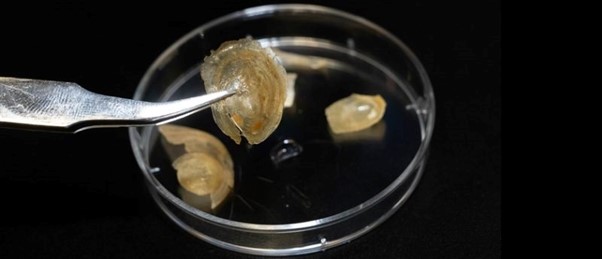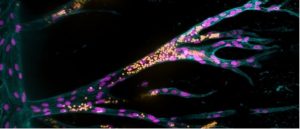The strange secret of a brachiopod shell

The mechanism that allows a species of brachiopod to change its shell from rigid to soft and flexible has been revealed, bringing with it new possibilities in the field of material sciences.
A recent paper, resulting from an international research collaboration led by Fabio Nudelman (University of Edinburgh, Scotland), documents a remarkable capability of the brachiopod Discinisca tenuis. The brachiopod can convert its shell from a hard, rigid state when dry to a soft, malleable state when wet. By establishing the mechanism behind this feat, the team believe their findings could inform the development of new smart materials for a range of applications.
This change in the shell’s state was first noted in western academia when Nudelman was sent a collection of Discinisca tenuis shells, sourced from their natural habitat on the coast of Namibia, by Maggie Cusack (Munster Technological University, Ireland). On receipt of the brachiopod shells, Nudelman went to wash the samples and found that the shells became soft and bendable after a few short minutes contact with water.
Surprised by the transformation, Nudelman set out to explore how the shell changed state so quickly, as similar transformations in response to changing environmental conditions usually require a significant amount of time and energy. “In its composition, the shell resembles bone. But bone doesn’t change its structure when it gets wet,” remarked Nudelman.
The first functionally vascularized synthetic hydrogel
To bioengineer functional tissue to repair damaged organs, a multitude of factors need to be considered. One aspect currently presenting bioengineers with a particular challenge, is the stimulation of angiogenesis in these replacement tissues in order to form functional blood vessels.
To examine the shell’s structure the team used a technique known as cryo-tomography, which involves utilizing ptychographic X-ray computed tomography while the sample is at a very low temperature to prevent the high-energy X-ray altering the sample’s structure. This approach was combined with electron microscopy and spectroscopy to reveal the hierarchical structure and composition of the shells when wet and dry.
The team found that the brachiopod’s shells are very similar to bones and teeth, consisting of inorganic minerals – in this instance predominantly fluorapatite – embedded with organic molecules. The fluorapatite was arranged in layers of small crystals with chitin and proteins occupying the space between the crystals. This connective ‘mortar’ absorbs the water and swells when wet. This, in turn, allows the crystals to move through the organic mortar, easily sliding past each other so that the shell is malleable.
As the species naturally inhabit the inter-tidal zone, the researchers hypothesize that this ability allows them to remain protected when dry and exposed to the elements or any potential predators and then adapt to absorb the force of the waves that could smash their 0.5 mm thick shells.
Looking to the potential application of this information in material science, the team elucidated the possibilities of this kind of control for materials that can alter their rigidity on demand, highlighting helmets that could adapt to a specific impact or replacements for injured bones.
